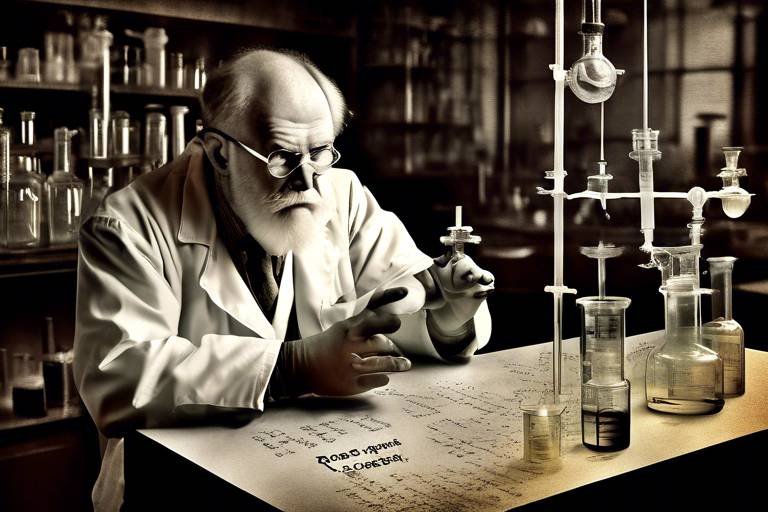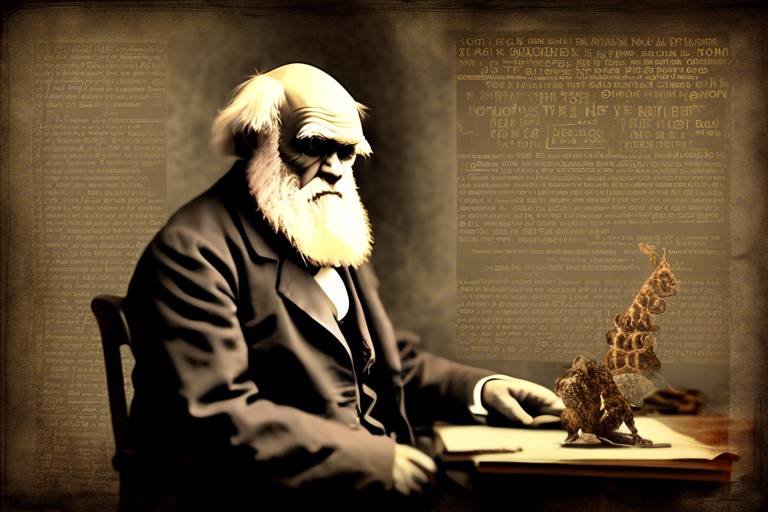The Legacy of Dmitri Mendeleev and the Periodic Table
Dmitri Mendeleev, a name synonymous with the periodic table, has left an indelible mark on the field of chemistry and science as a whole. His innovative approach not only revolutionized how we understand elements but also paved the way for future discoveries and advancements. Imagine a world where the elements were just a chaotic mix, lacking any structure or organization. Mendeleev brought order to this chaos, creating a framework that not only classified known elements but also predicted the existence of those yet to be discovered. His legacy is not merely in the table itself but in the profound impact it has had on scientific thought and education.
Born in 1834 in Siberia, Mendeleev's journey to becoming a pioneering chemist was anything but straightforward. He faced numerous challenges, including financial hardships and the loss of family members at a young age. However, his insatiable curiosity and determination led him to study chemistry at the University of St. Petersburg, where he excelled and eventually became a professor. It was during these formative years that Mendeleev began to formulate ideas that would later culminate in the creation of the periodic table. His experiences shaped his understanding of the elements, allowing him to see patterns where others saw chaos.
The creation of the periodic table was not a mere stroke of genius; it was the result of meticulous research and an innate understanding of elemental properties. Mendeleev organized elements based on their atomic weights and chemical properties, revealing a periodicity that was groundbreaking at the time. This systematic approach was revolutionary, as it allowed scientists to predict the behavior of elements and their compounds. Mendeleev's periodic table was not just a tool; it was a lens through which we could view the relationships between different elements, making it easier to understand chemical reactions and properties.
As we delve deeper into Mendeleev's life, we see a tapestry woven with passion for knowledge and relentless pursuit of truth. His early education was marked by a thirst for learning that set him apart from his peers. Mendeleev's ability to connect dots between seemingly unrelated concepts was evident even in his youth. He was not just learning; he was absorbing information and seeking to understand the underlying principles of the natural world.
When Mendeleev finally unveiled his periodic table in 1869, it was met with awe and skepticism. The table was a bold statement, showcasing not only the elements known at the time but also leaving gaps for those that had yet to be discovered. This foresight was a testament to Mendeleev's deep understanding of atomic theory. He didn't just organize elements; he made predictions that would challenge the scientific community. What if there were elements that shared properties with those already known? Mendeleev's table suggested that they existed, waiting to be found.
Mendeleev's predictions were nothing short of extraordinary. For instance, he anticipated the existence of gallium, which was discovered in 1875. This element fit perfectly into the gap Mendeleev had left in his table, and its properties matched his predictions almost exactly. This moment was a turning point in chemistry, solidifying Mendeleev's reputation as a visionary. His ability to foresee the existence of elements before they were discovered highlighted not just his genius but also the power of the periodic table as a scientific tool.
The discovery of gallium was a validation of Mendeleev's work and an explosion of excitement in the scientific community. Imagine the thrill of finding a missing piece of a puzzle that had been waiting to be discovered for years! Gallium's properties aligned with Mendeleev's predictions, reinforcing the credibility of the periodic table. This moment not only confirmed Mendeleev's theories but also sparked further exploration into the world of elements, leading to the discovery of many more.
Mendeleev's periodic table revolutionized the field of chemistry, providing a framework that scientists still rely on today. It transformed how we understand elemental properties and relationships, enabling chemists to predict the behavior of substances in reactions. The periodic table is more than just a chart; it's a roadmap of the universe, guiding us through the complexities of chemical interactions. Mendeleev's work laid the groundwork for modern chemistry, influencing countless discoveries and innovations.
At the heart of Mendeleev's work lies the periodic law, which states that the properties of elements are a periodic function of their atomic weights. This principle established a systematic way to categorize elements, allowing scientists to make sense of the vast array of substances found in nature. The periodic law is the backbone of the periodic table, providing a structure that has stood the test of time and continues to evolve as new discoveries are made.
Since Mendeleev's time, the periodic table has undergone significant evolution. New elements have been discovered, and modern theories have expanded our understanding of atomic structure. Today, the table includes elements that Mendeleev could only dream of, with advancements in technology allowing scientists to explore the atomic world in ways previously unimaginable. The periodic table is a living document, constantly updated as our knowledge grows.
Recent additions to the periodic table include elements like oganesson and livermorium, showcasing the ongoing exploration of the atomic world. Each new discovery brings with it a wealth of information, challenging our existing knowledge and prompting further research into the properties and behaviors of these elements. The quest for understanding continues, driven by curiosity and the desire to unlock the secrets of the universe.
Advancements in technology have played a crucial role in shaping our understanding of the periodic table. From sophisticated particle accelerators to advanced imaging techniques, technology has enhanced our ability to study and categorize elements. These tools have opened new avenues for research, allowing scientists to delve deeper into the atomic world and uncover the mysteries that lie within. The marriage of technology and chemistry is a powerful force, driving innovation and discovery.
- Who is Dmitri Mendeleev? - Dmitri Mendeleev was a Russian chemist known for creating the periodic table of elements and predicting the properties of undiscovered elements.
- What is the periodic table? - The periodic table is a systematic arrangement of elements based on their atomic number, electron configuration, and recurring chemical properties.
- How did Mendeleev predict new elements? - Mendeleev used patterns in the properties of known elements to predict the existence and properties of undiscovered elements.
- What is the significance of gallium in Mendeleev's work? - The discovery of gallium validated Mendeleev's predictions and reinforced the accuracy of his periodic table.
- How has the periodic table evolved since Mendeleev's time? - The periodic table has expanded to include new elements and has been refined with modern scientific theories and discoveries.

The Life of Dmitri Mendeleev
Dmitri Mendeleev, a name synonymous with chemistry, was born on February 8, 1834, in the small town of Tobolsk, Siberia. He was the youngest of 14 children in a family that faced numerous hardships, especially after his father, a teacher, passed away when Mendeleev was just a child. Despite these challenges, Mendeleev's mother, a strong and determined woman, encouraged him to pursue education. This early support was pivotal, as it set the foundation for a life dedicated to learning and discovery.
Mendeleev's educational journey began at the Tobolsk Gymnasium, where he displayed a natural aptitude for science and mathematics. In 1850, he moved to St. Petersburg to study at the University of St. Petersburg, where he earned his degree in 1856. His time at the university was marked by a thirst for knowledge and a desire to understand the natural world. Mendeleev's professors recognized his potential, and he quickly became involved in research, focusing on chemistry and physics.
After completing his degree, Mendeleev traveled to Western Europe to further his studies. He spent time in Germany, France, and other countries, absorbing the latest scientific advancements. This exposure to different scientific methodologies and theories enriched his understanding and ultimately influenced his groundbreaking work on the periodic table. Mendeleev returned to Russia in 1861, where he began teaching at the Technological Institute and later at the University of St. Petersburg.
Throughout his career, Mendeleev faced various obstacles, including skepticism from some of his contemporaries. However, his passion for chemistry and his relentless pursuit of knowledge drove him to continue his research. Mendeleev's experiences, both personal and professional, shaped his innovative thinking and laid the groundwork for his most significant achievement—the creation of the periodic table.
In his quest to organize the elements, Mendeleev was not just a scientist; he was a visionary. He believed that understanding the relationships between elements would unlock the mysteries of chemistry. His life story is a testament to the power of perseverance and intellectual curiosity, demonstrating that even in the face of adversity, one can achieve greatness through dedication and hard work.
- What inspired Mendeleev to create the periodic table?
Mendeleev was inspired by the need to organize the known elements in a way that highlighted their relationships and properties, which he believed would lead to further discoveries. - How did Mendeleev's early life influence his work?
Growing up in a challenging environment instilled in Mendeleev a strong work ethic and a desire for knowledge, which were crucial in his scientific pursuits. - What was Mendeleev's greatest achievement?
His greatest achievement is undoubtedly the formulation of the periodic table, which revolutionized the field of chemistry and provided a systematic framework for understanding elemental properties.

The Creation of the Periodic Table
The journey to creating the periodic table was nothing short of a scientific odyssey, and at the heart of it was the visionary Dmitri Mendeleev. In the mid-19th century, the field of chemistry was in a state of flux, with numerous elements being discovered and classified, yet no systematic approach to organizing them existed. Mendeleev, with his keen analytical mind, recognized the need for a coherent framework to categorize the elements based on their properties and atomic weights.
In 1869, Mendeleev unveiled his periodic table, which was revolutionary for its time. He arranged the elements in rows according to increasing atomic weight, creating columns of elements that shared similar chemical properties. This organization was not merely arbitrary; it was based on the periodic law, which states that the properties of elements are a periodic function of their atomic weights. Mendeleev's table was a visual representation of this law, showcasing the relationships between various elements.
What made Mendeleev's approach particularly innovative was his use of gaps in the table. He boldly left spaces for elements that had not yet been discovered, predicting their existence and properties with remarkable accuracy. For instance, he anticipated the discovery of elements such as gallium and germanium, which would later fill these gaps. This foresight not only demonstrated his deep understanding of atomic theory but also established him as a pioneer in the field of chemistry.
To illustrate Mendeleev's method, let’s look at a simplified version of his periodic table:
| Element | Symbol | Atomic Weight |
|---|---|---|
| Hydrogen | H | 1.008 |
| Helium | He | 4.0026 |
| Lithium | Li | 6.94 |
| Beryllium | Be | 9.0122 |
| Boron | B | 10.81 |
| Carbon | C | 12.011 |
This table is just a glimpse of the extensive work Mendeleev accomplished. By organizing elements in this way, he provided a tool that not only helped chemists understand the elements better but also predicted the behavior of undiscovered ones. The periodic table became a crucial reference point for scientists, allowing them to make connections and draw conclusions about elemental properties.
In summary, Mendeleev's creation of the periodic table was not just a scientific achievement; it was a monumental leap that changed the landscape of chemistry forever. His ability to see beyond the known elements and predict the existence of others set a precedent for future scientific inquiry and exploration. The periodic table remains an essential part of chemistry today, a testament to Mendeleev's genius and a symbol of the unending quest for knowledge in the scientific community.

Mendeleev’s Predictions
Dmitri Mendeleev was not just a chemist; he was a visionary who had an uncanny ability to foresee the future of chemistry. When he created the periodic table, he didn't merely arrange elements based on their properties; he made bold predictions about elements that had yet to be discovered. Imagine standing on the edge of a cliff, peering into an abyss, and somehow knowing that there are solid ground and treasures waiting for you on the other side. That was Mendeleev's approach to the unknown elements of his time.
His predictions were rooted in a profound understanding of atomic theory and the relationships between elements. Mendeleev left gaps in his periodic table for these undiscovered elements, suggesting their existence and even predicting their properties. For instance, he predicted the existence of a then-unknown element he called "eka-silicon," which would eventually be discovered as germanium. He confidently asserted that this new element would possess specific properties, such as an atomic weight between that of silicon and tin, and even outlined its anticipated density and reactivity.
To illustrate the remarkable accuracy of Mendeleev's predictions, we can look at a few key elements he foresaw:
| Predicted Element | Actual Element | Year Discovered | Properties Predicted |
|---|---|---|---|
| Eka-silicon | Germanium | 1886 | Similar to silicon and tin |
| Eka-boron | Gallium | 1875 | Melting point, density, and chemical behavior |
| Eka-aluminum | Indium | 1863 | Properties similar to aluminum |
Mendeleev's ability to predict these elements was not merely guesswork; it was grounded in the periodic law he formulated, which stated that the properties of elements are a periodic function of their atomic weights. This law provided a systematic way to categorize elements, allowing him to make educated predictions about their properties based on their position in the periodic table.
His predictions were met with skepticism at first. After all, how could one man confidently assert the existence of elements that no one had yet seen? However, as each new element was discovered and matched Mendeleev's predictions, his reputation grew. The scientific community began to see him not just as a chemist, but as a prophet of the atomic age.
In conclusion, Mendeleev's predictions about undiscovered elements were a testament to his genius. They showcased not just his understanding of chemistry, but also his remarkable foresight. His work laid the foundation for future discoveries and continues to inspire scientists today. Mendeleev's legacy is a reminder that sometimes, the greatest discoveries come from those who dare to look beyond the known and imagine what could be.
- What was Mendeleev's most significant contribution to chemistry?
Mendeleev's most significant contribution was the creation of the periodic table, which organized elements based on their properties and atomic weights, allowing for predictions of undiscovered elements. - How did Mendeleev predict the properties of undiscovered elements?
Mendeleev utilized the periodic law, which states that the properties of elements are a periodic function of their atomic weights, allowing him to make educated guesses about the properties of unknown elements. - Which elements did Mendeleev predict?
He predicted several elements, including germanium (eka-silicon), gallium (eka-boron), and indium (eka-aluminum), all of which were later discovered and matched his predictions.

The Discovery of Gallium
The year was 1875, and the world of chemistry was on the brink of a revolution, thanks to the visionary work of Dmitri Mendeleev. Among the many elements that danced on the pages of his periodic table, one element stood out like a shimmering gem waiting to be discovered: Gallium. Mendeleev had predicted not just its existence, but also its properties, a feat that would soon be validated by the scientific community.
Gallium was not just another element; it was a testament to Mendeleev's genius. When he first published his periodic table, he left blank spaces for elements that were yet to be discovered, suggesting their properties based on the patterns he observed. This foresight was revolutionary, and it was about to pay off. In 1875, French chemist Paul-Émile Lecoq de Boisbaudran successfully isolated gallium, confirming Mendeleev's predictions.
Imagine the excitement in the scientific community! Mendeleev had predicted that gallium would have an atomic weight of approximately 68, and its properties would resemble those of aluminum. When Lecoq de Boisbaudran announced the discovery, he found that gallium had an atomic weight of 69.72, which was astonishingly close to Mendeleev's estimate. This not only validated Mendeleev's periodic table but also solidified his reputation as a pioneering chemist.
To illustrate the significance of this discovery, let’s take a look at the predicted vs. actual properties of gallium:
| Property | Predicted by Mendeleev | Actual Value |
|---|---|---|
| Atomic Weight | 68 | 69.72 |
| Appearance | Metallic | Metallic |
| Melting Point | 29.76 °C | 29.76 °C |
Gallium’s discovery was more than just a scientific milestone; it was a powerful affirmation of the periodic law that Mendeleev had proposed. This moment marked a turning point in chemistry, showcasing how the periodic table could predict the existence and properties of elements yet to be discovered. Mendeleev’s ability to foresee gallium's characteristics was akin to a master artist sketching a masterpiece before the canvas was even painted.
In the grand tapestry of scientific achievement, the discovery of gallium stands as a shining example of how theoretical predictions can lead to tangible discoveries. It proved that Mendeleev's periodic table was not just a collection of elements but a dynamic framework that could guide future research and exploration in the field of chemistry.

The Impact on Chemistry
Dmitri Mendeleev's periodic table was nothing short of a revolution in the field of chemistry. Before his groundbreaking work, the elements were a chaotic mix, with no systematic way to categorize them. Mendeleev's approach brought order to this chaos, allowing chemists to understand elemental properties and their relationships in a way that had never been done before. Imagine trying to navigate a city without a map—Mendeleev provided that map for the world of chemistry.
His periodic table laid the foundation for modern chemistry by introducing the concept of the periodic law, which states that the properties of elements are a periodic function of their atomic weights. This was a game-changer, as it allowed scientists to predict the properties of elements yet to be discovered. Mendeleev's table was more than just a chart; it was a tool that enabled chemists to explore and understand the building blocks of matter.
One of the most significant impacts of Mendeleev's work was the ability to predict the existence of new elements. For instance, he left gaps in his periodic table for elements that had not yet been discovered, confidently asserting that they would eventually be found. This foresight not only validated his work but also inspired future generations of scientists to explore the unknown. The discovery of gallium in 1875, which matched Mendeleev's predictions, was a testament to his visionary approach. It was as if he had a crystal ball, peering into the future of chemistry.
Furthermore, Mendeleev's periodic table provided a framework that has been built upon by countless scientists. It allowed for the identification of trends among elements, such as reactivity, electronegativity, and ionization energy. These trends have become essential for predicting how different elements will interact with one another, paving the way for advancements in various fields, including materials science, medicine, and environmental science.
In addition to its practical applications, Mendeleev's periodic table has a profound philosophical impact. It challenges us to think about the nature of scientific knowledge itself—how it evolves and how our understanding of the universe is interconnected. The periodic table is a symbol of the quest for knowledge, illustrating how science is a constantly evolving discipline, much like the elements it categorizes.
In summary, Mendeleev's periodic table did not just change chemistry; it transformed it into a more dynamic and predictive science. It allowed chemists to see the relationships between elements and provided a platform for future discoveries. Without Mendeleev's contributions, our understanding of chemistry would be far less rich and complex.
- What was Mendeleev's greatest contribution to chemistry?
Mendeleev's greatest contribution was the creation of the periodic table, which organized elements based on their atomic weights and properties, allowing for the prediction of undiscovered elements. - How did Mendeleev predict new elements?
Mendeleev left gaps in his periodic table for elements that had not yet been discovered, using the known properties of surrounding elements to infer the properties of these unknowns. - What is the significance of the periodic law?
The periodic law established a systematic method for categorizing elements, which has become a fundamental principle in chemistry, helping scientists understand elemental behavior and relationships.

The Periodic Law
The Periodic Law, a cornerstone of modern chemistry, was articulated by Dmitri Mendeleev in the late 19th century. This law states that the properties of elements are a periodic function of their atomic weights, which means that when elements are arranged in order of increasing atomic weight, certain properties recur at regular intervals. Imagine a musical scale where notes repeat in a predictable pattern; similarly, the periodic table reveals a rhythm in the behavior of elements. Mendeleev's insight into this pattern was groundbreaking, providing a systematic approach to understanding the relationships between different elements.
To grasp the significance of the Periodic Law, we must consider how Mendeleev organized the elements. He created a table that not only listed the known elements but also left spaces for those yet to be discovered. This foresight was revolutionary; it suggested that elements were not just isolated entities but part of a larger, interconnected family. For instance, he grouped elements with similar chemical properties together, which paved the way for future discoveries and classifications.
One of the most fascinating aspects of the Periodic Law is its predictive power. Mendeleev didn't just categorize elements; he predicted the existence and properties of several elements that had not yet been discovered. For example, he left a gap in his table for what he called "eka-silicon," which we now know as germanium. This predictive aspect not only validated Mendeleev's work but also established a new standard in scientific inquiry, where theories could be tested and verified through future discoveries.
Over the years, the Periodic Law has evolved with advancements in atomic theory and the discovery of new elements. Today, the periodic table is organized by atomic number rather than atomic weight, a change that has refined our understanding of elemental properties. However, the essence of Mendeleev's insight remains intact; the periodic relationships among elements continue to guide chemists in their research and applications.
To illustrate the impact of the Periodic Law, consider the following table, which summarizes key elements and their properties based on Mendeleev's original classifications:
| Element | Atomic Weight | Group | Predicted Properties |
|---|---|---|---|
| Silicon (Si) | 28.09 | 14 | Non-metal, semiconductor |
| Germanium (Ge) | 72.63 | 14 | Metalloid, similar to silicon |
| Gallium (Ga) | 69.72 | 13 | Metal, low melting point |
This table not only highlights Mendeleev's classifications but also serves as a reminder of his extraordinary ability to foresee the relationships among elements. The Periodic Law continues to be a guiding principle in chemistry, influencing everything from academic research to practical applications in technology and medicine.
- What is the Periodic Law? The Periodic Law states that the properties of elements are a periodic function of their atomic weights.
- How did Mendeleev contribute to the Periodic Law? Mendeleev organized the elements into a table based on their atomic weights and predicted the existence of undiscovered elements.
- How has the Periodic Law changed over time? The Periodic Law has evolved to focus on atomic number rather than atomic weight, refining our understanding of elemental relationships.

Modern Developments in the Periodic Table
Since the time of Dmitri Mendeleev, the periodic table has undergone significant transformations, evolving into a dynamic tool that reflects our growing understanding of chemistry. Mendeleev's original table was revolutionary, but as science progressed, so did our comprehension of atomic structure and elemental properties. Today, we have a more refined periodic table that not only includes new elements but also incorporates advanced theories that enhance our grasp of the universe.
One of the most striking developments in the periodic table has been the discovery of new elements. The periodic table has expanded to include elements beyond those known in Mendeleev's era. For instance, elements like oganesson (Og), discovered in 2002, and tennessine (Ts), discovered in 2010, are now part of the table, showcasing the ongoing quest for knowledge in the field of chemistry. These discoveries are often the result of collaborative efforts in laboratories around the world, where scientists use advanced techniques to synthesize these elements.
Moreover, the categorization of elements has also evolved. While Mendeleev organized elements primarily by their atomic weights, modern chemists utilize atomic numbers as the basis for organization. This shift has led to a clearer understanding of elemental properties and their relationships. The modern periodic table is now divided into metals, nonmetals, and metalloids, providing a more intuitive layout for understanding how elements interact with one another.
| Category | Examples |
|---|---|
| Metals | Iron (Fe), Gold (Au), Copper (Cu) |
| Nonmetals | Oxygen (O), Nitrogen (N), Sulfur (S) |
| Metalloids | Silicon (Si), Boron (B), Arsenic (As) |
Technology has also played a pivotal role in the study of the periodic table. Advanced tools such as mass spectrometry and particle accelerators have enabled scientists to delve deeper into the atomic world. These technologies not only assist in the discovery of new elements but also help in understanding the behavior of existing ones under various conditions. For instance, researchers can now simulate the extreme conditions of outer space in a laboratory setting, allowing them to study the properties of elements that might exist in stars or other celestial bodies.
Furthermore, ongoing research continues to challenge and refine our understanding of the periodic table. Scientists are investigating the potential for new synthetic elements and exploring the properties of superheavy elements, which are located at the bottom of the periodic table. These elements often exhibit unique characteristics that could lead to groundbreaking applications in fields such as materials science and medicine.
In summary, the periodic table is no longer a static chart but a living document that reflects our expanding knowledge of the chemical world. With each new discovery and technological advancement, we are one step closer to unraveling the mysteries of the universe. The legacy of Mendeleev lives on, inspiring future generations of scientists to push the boundaries of what we know and to continue exploring the fascinating world of chemistry.
- What is the periodic table? The periodic table is a tabular arrangement of chemical elements, organized by their atomic number, electron configuration, and recurring chemical properties.
- How has the periodic table changed since Mendeleev's time? The periodic table has expanded to include new elements, and the organization has shifted from atomic weight to atomic number, enhancing our understanding of elemental relationships.
- What technologies are used to discover new elements? Technologies such as mass spectrometry and particle accelerators are crucial for synthesizing and studying new elements.

New Elements and Discoveries
Since the groundbreaking work of Dmitri Mendeleev, the periodic table has undergone significant evolution, reflecting the dynamic nature of scientific inquiry. New elements continue to be discovered and synthesized, expanding our understanding of atomic structure and the fundamental building blocks of matter. For instance, the discovery of elements beyond uranium, known as transuranium elements, has opened up a new realm of possibilities in chemistry. These elements, such as neptunium, plutonium, and more recently, oganesson, have unique properties that challenge our previous notions of the periodic table.
One of the most exciting aspects of modern chemistry is the ability to create synthetic elements in laboratories. These elements, often highly unstable and radioactive, can provide insights into the forces that hold atoms together, as well as the limits of atomic theory itself. The discovery of element 118, oganesson, is a prime example. This element is not only the heaviest known but also exhibits unusual properties that differ significantly from those of lighter noble gases. Its existence challenges scientists to rethink the behavior of elements as they increase in atomic number.
Moreover, advancements in technology have greatly enhanced our ability to discover and study new elements. High-energy particle accelerators, for instance, enable researchers to collide atoms at incredible speeds, creating conditions that mimic those found in stellar explosions. This process can lead to the formation of new, heavier elements. The following table summarizes some of the most recent discoveries in the periodic table:
| Element | Symbol | Atomic Number | Year Discovered |
|---|---|---|---|
| Oganesson | Og | 118 | 2002 |
| Livermorium | Lv | 116 | 2012 |
| Copernicium | Cn | 112 | 2009 |
| Flerovium | Fl | 114 | 2011 |
As we delve deeper into the mysteries of the atomic world, each new discovery not only adds to the periodic table but also prompts further questions about the nature of matter itself. What other elements lie beyond our current understanding? How might these discoveries impact fields such as medicine, energy, and materials science? The journey of exploration is far from over, and the periodic table continues to be a living document that evolves with each scientific breakthrough.
In conclusion, the legacy of Dmitri Mendeleev lives on through the ongoing discoveries and advancements in the field of chemistry. Each new element serves as a reminder of the foundational principles he established and the limitless potential of scientific exploration. As we look to the future, the periodic table remains a testament to human curiosity and ingenuity, inviting us to uncover the secrets that lie within the fabric of our universe.
- What is the most recently discovered element? The most recently discovered element is Oganesson (Og), with an atomic number of 118, discovered in 2002.
- How are new elements created? New elements are typically created in laboratories using particle accelerators, where atoms are collided at high speeds to form heavier elements.
- Why are some elements unstable? Many synthetic elements are unstable due to their large atomic numbers, leading to a high likelihood of radioactive decay.
- What is the significance of the periodic table? The periodic table organizes elements based on their atomic number, electron configuration, and recurring chemical properties, providing a framework for understanding chemical behavior.

The Role of Technology
In the ever-evolving landscape of science, technology has played a pivotal role in enhancing our understanding of the periodic table. Imagine the periodic table as a vast ocean of elements, each one unique and full of potential. Just as technology has allowed us to explore the depths of the ocean, it has enabled chemists and scientists to dive deeper into the mysteries of atomic structure and elemental properties. From advanced imaging techniques to sophisticated computational models, technology has transformed how we study and categorize these fundamental building blocks of matter.
One of the most significant advancements has been in the realm of spectroscopy. This technique allows scientists to analyze the light emitted or absorbed by elements, providing critical insights into their atomic structure and behavior. By using spectrometers, researchers can identify elements in distant stars or analyze the composition of materials right here on Earth. This not only expands our knowledge of existing elements but also aids in the discovery of new ones, as scientists can now detect minute quantities of substances that would have gone unnoticed in the past.
Moreover, the advent of computational chemistry has revolutionized the way we approach the periodic table. With powerful algorithms and simulations, chemists can predict the properties of undiscovered elements and assess their potential behaviors before they are even synthesized in a lab. This predictive capability is akin to having a crystal ball, allowing researchers to map out the future of chemistry. For instance, using quantum mechanics, scientists can calculate how an element might react under various conditions, providing invaluable guidance for practical applications.
Another remarkable development is the use of nanotechnology. As we delve into the nanoscale, the properties of elements can change dramatically. This new realm of science has opened doors to innovative materials and applications, from stronger alloys to more efficient catalysts. By manipulating elements at the atomic level, researchers can create materials with tailored properties, pushing the boundaries of what we thought was possible. The periodic table is no longer just a static reference; it is a dynamic tool that continues to evolve with our technological advancements.
Furthermore, the integration of artificial intelligence (AI) into chemical research has begun to reshape our understanding of the periodic table. AI algorithms can process vast amounts of data, identifying patterns and relationships that human researchers might overlook. This capability accelerates the discovery of new elements and compounds, as AI can suggest potential candidates for synthesis based on existing data. Imagine having a virtual assistant that not only organizes information but also provides insights and recommendations based on complex calculations! This is the future of chemistry, where technology and human intellect collaborate to unravel the mysteries of the universe.
In summary, technology has become an indispensable ally in the exploration of the periodic table. From spectroscopy and computational chemistry to nanotechnology and AI, these advancements are not just enhancing our understanding—they are redefining it. As we continue to innovate, who knows what new elements and properties we will uncover? The periodic table is a living document, one that grows and evolves alongside our technological capabilities, and the journey of discovery is far from over.
- What is the periodic table? The periodic table is a tabular arrangement of chemical elements, organized by their atomic number, electron configuration, and recurring chemical properties.
- Who created the periodic table? Dmitri Mendeleev is credited with creating the first widely recognized periodic table in 1869, which organized elements based on their atomic weights and properties.
- How has technology impacted the study of the periodic table? Technology has enabled advanced techniques such as spectroscopy, computational chemistry, nanotechnology, and AI, enhancing our understanding and discovery of elements.
- What role does AI play in chemistry? AI aids in processing large datasets, identifying patterns, and predicting the properties of undiscovered elements, streamlining research and discovery processes.
Frequently Asked Questions
- Who was Dmitri Mendeleev?
Dmitri Mendeleev was a Russian chemist best known for creating the periodic table of elements. His work laid the foundation for modern chemistry by organizing elements based on their atomic weights and properties, allowing scientists to predict the existence of new elements.
- What is the significance of the periodic table?
The periodic table is significant because it provides a systematic way to understand the relationships between different elements. It helps chemists predict how elements will react with one another, making it an essential tool in both educational and research settings.
- How did Mendeleev create the periodic table?
Mendeleev created the periodic table by arranging elements in order of increasing atomic weight while grouping them according to their chemical properties. This innovative approach revealed periodic trends, which allowed him to leave gaps for undiscovered elements, showcasing his forward-thinking vision.
- What were Mendeleev’s predictions about undiscovered elements?
Mendeleev made bold predictions about the properties of elements that had not yet been discovered. For instance, he predicted the existence of gallium, which was discovered shortly after his table was published, confirming the accuracy of his predictions and solidifying his reputation in the scientific community.
- How did the discovery of gallium validate Mendeleev's work?
The discovery of gallium in 1875 validated Mendeleev's work by confirming his predictions about its properties. This not only reinforced the credibility of his periodic table but also demonstrated the power of his systematic approach to organizing elements.
- What is the periodic law?
The periodic law, formulated by Mendeleev, states that the properties of elements are a periodic function of their atomic weights. This means that when elements are arranged in order of increasing atomic weight, their chemical properties exhibit a recurring pattern.
- How has the periodic table evolved since Mendeleev's time?
Since Mendeleev's time, the periodic table has evolved with the discovery of new elements and the development of modern theories in chemistry. Today, elements are categorized not only by atomic weight but also by atomic number, leading to a more accurate representation of elemental properties.
- What role does technology play in studying the periodic table?
Technology plays a crucial role in studying the periodic table by providing advanced tools and techniques for discovering new elements and understanding atomic structure. Innovations in spectroscopy, particle physics, and computational chemistry have greatly enhanced our ability to explore and categorize elements.
- Are there any new elements added to the periodic table recently?
Yes, recent years have seen the addition of new elements to the periodic table, such as nihonium, moscovium, livermorium, tennessine, and oganesson. These discoveries continue to expand our understanding of chemistry and the behavior of matter at the atomic level.



















